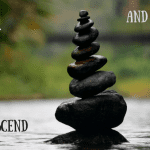
I am a pluralist. I guess it is implied in the Interfaith Minister title. Rainbow society. Let’s all be friends. Peace on earth. I like those ideas.
But somewhere along the way, pluralism, and postmodernism with it (you can probably substitute the word postmodernism with pluralism throughout this piece) got infected and lost its way.
How, you ask? Well, if you are at all concerned with the rise of extremism, the post-truth culture we live in, or are unhappy with the trajectory of the politically correct (PC) culture, you should read the following excerpt from my book Trans-Rational Spirituality that was published in 2015.
I hope you will find the excerpt to be both thought-provoking and illuminating. It’s a longer than usual read, and some of it will probably rub you the wrong way. However, if you ascribe to pluralism, as I do, I encourage you to read on. Carl Jung famously posited that everything that irritates us externally (about others) can lead to an increased internal understanding (of ourselves).
We need to understand where pluralism went wrong and what we can do about it.
Like it Or Not, Postmodernism Colors Our Worldview
Without discounting the immense influence of popular culture, consumerism, and environmental degradation, I contend that, in the West, the most influential paradigm in regards to religion and spirituality [and society in general] since the 1960’s has been postmodernism.
Allow me to explain.
The preceding worldview of modernity — brought on by the Age of Enlightenment, beginning in the seventeenth century — centered on universal truths and the idea that the world could be perfected through democracy, progress, reason, and technology. Reason was trumpeted above all else. Religious myth was considered a thing of the past.
Then, in the latter half of the twentieth century, postmodernism upended everything. Universal truths were no longer accepted. “Truth” (postmodernism loves quotation marks) was instead a social construct that depended heavily on cultural context. Nothing was either true or false, but was instead open to interpretation.
This interpretive climate has colored our existence in more ways than one. To begin with, it is thanks to postmodernism that people can refer to themselves as culturally religious. The ability to separate culture from personal belief has permitted people to keep religious traditions, such as the celebration of Christmas, without embracing every part of the mythologies from which they sprang. Prior to postmodernism, it was all but impossible to claim that one was a cultural Christian, Jew, or Muslim. There was no such thing. Now, being culturally religious is a widely accepted stance.
This cultural contextualization has further allowed for a movement in another direction; namely, allowing the separation of spiritual practices such as meditation from mythical teachings such as the belief in Hindu gods and goddesses. This is an important distinction. The healthy version of this approach attempts to rationally strip away cultural influences and myths from experiential practices and philosophical concepts, while the unhealthy version is a pick-and-choose method.
Postmodernism has had several other positive effects on our culture, such as the insistence on extending rights to all individuals regardless of gender, race, or sexual orientation, and the idea of not wanting to marginalize any point of view.
With this in mind, it is no wonder that cities, where people from all over the world live amicably together, tend to be more pluralistic in their views than their traditionally narrower-minded counterparts in rural areas, where preaching to the choir and being around people who are the same or similar is the norm.
On the whole, it seems that being exposed to a number of different viewpoints, respecting differences, and finding commonalities are all positive additions to the previous worldview.
That’s where the postmodern multicults got it right.
However, they got it wrong when they started viewing all perspectives as equal.
“No Absolute Truths”
When taken to extremes, the postmodern worldview completely rejects absolutism — a paradox in itself. By claiming that “there are no absolute truths” the postmodern stance is also claiming that the statement it just made is an absolute truth, trying to have it both ways by rejecting absolutism with absolutism.
Postmodernism further says that it gives equal rise to all perspectives when, in reality, postmodernism gives rise to all perspectives except those that don’t give equal rise to all perspectives — those are politically correct cannon fodder.
We, in the West, have been given permission to attack any person or institution that in any way marginalizes others, be it on the basis of race, religion, politics, or . . . anything else, really.
This has become a delightful pastime for some; reveling in righteous rage and attacking (never physically, but rather through some form of media) any worldview that seems to marginalize another worldview (homophobes and religious fanatics are fan favorites). Such public shaming is rampant and sometimes appropriate, but unfortunately, in recent years, shaming has morphed into coordinated reputation murders, and anyone who is slightly insensitive or not PC enough can be led to a public character lynching without due process.
The contradiction is apparent to anyone who stops to think for a moment. At the same time that postmodernism encourages us to criticize those who marginalize (which makes marginalization the chief transgression), we are, confusingly, also encouraged to marginalize.
How can we do that and give equal rise to every perspective at the same time?
It is an impossible task.
And that is not the only confusing thing about this philosophical stance.
“Nothing is better or worse — there are only different perspectives,” says postmodernism.
“Really?” we ask. “There is no difference between ISIS and Doctors Without Borders? Mother Teresa wasn’t better than Hitler?”
When those kinds of questions are asked, we all answer, “Of course there is a difference,” but we then have a hard time pinpointing why, that is, unless we start accepting evolutionary psychological growth models.
This presents us with yet another problem. We can’t conscientiously accept growth models and remain pluralistic. No, postmodernism rejects growth models because they are perceived as hierarchical and judgmental (the original sin of postmodernism).
I must confess that when I was first introduced to growth models they solved many ideological problems for me and yet, the more I thought about them, the more parts of their hierarchical structures seemed condemnatory. They failed to align with the pluralistic postmodern battle cry of “no one is better than anyone else” (a stance I firmly believed in at the time).
Fortunately, Howard Gardner’s multiple intelligence theory solved that problem, taking multiple lines of development into account. Through this lens, I could see that people can be more or less evolved in different areas.
After having been around many self-titled spiritual masters, I could finally answer the question, “How can he be so spiritually evolved when he meditates and yet such an idiot when it comes to personal interactions?” The answer was hidden in different lines of development — in this case, the difference between spiritual and interpersonal development.
This also put me in my place, because although I consider myself somewhat evolved in certain areas, I am still on the ground floor in others.
The incongruity is that if postmodernism would just accept psychological growth models, then it could finally point to certain cross-cultural truths, such as the fact that compassionate altruism (displayed by Doctors Without Borders) is better than violent fundamentalism (portrayed by ISIS).
And yet, for most of us, the idea of different levels of growth is still inherently foreign. From birth, most of us have been inundated in moral pluralism, giving equal weight to everything, and that has led to extremes and perversions of its own.
For example, the call for equal rights has perverted into “let’s all be the same.” Male and female biological differences are discounted, because “male” and “female” are considered “outdated social constructs,” and while that is partially true, the social construct stance becomes clear reductionism when it totally discounts clear differences in male and female biology (i.e., androgyny is not the same as equality).
Furthermore, when someone points to the very real fact that there are egocentric slackers in our society who need a strong framework, such as the ones found in the army or in churches, we freak out.
We are only recently realizing (as explained in chapter one) that for a person who is chaotically egocentric, it is a step up to be accepted into a fundamentalist group (and note that there are healthy and unhealthy versions of fundamentalism, as the unhealthy version usually promotes exclusion and violence). The person being converted needs to fully invest in a rigidly structured worldview before she can see its limitations and continue to the more skeptical, pluralistic worldview.
But our inherited, postmodern worldview doesn’t see it that way. No, all fundamentalism is bad, for everyone, at all times!
The Resurgence of Fundamentalism and Extremism
The irony is that postmodernism created a philosophical vacuum for the resurgence of fundamentalism [and extremism].
Modernity, with its battle cry of “no more myths” (Voltaire), had all but eradicated fundamentalism from mainstream culture. Writings from the 1800s and early 1900s suggest that literalist mythical beliefs, even the act of praying, were on the defensive. Reason was king and kings were out (along with other forms of aristocracy).
Modernity was exemplified by the US Constitution, which cut the cord between religion and politics, an unbreakable bond until then.
In an unfortunate turn of events, that bond has since been reinstituted, thanks to Biblical populism. The phrase “In God We Trust” has replaced the inherently pluralistic “E Pluribus Unum” and “God Bless America” is repeatedly used in our chambers of government — neither phrase is an example of patriotism, but rather of theocracy.
“How exactly did postmodernism help the resurgence of fundamentalism?” you ask.
By taking the stance that “nothing is better than anything else.” With that as a motto, postmodernism could not explain or qualify its stance against fundamentalism.
Today, religious fanatics and scientific rejectionists flourish under the protective wing of postmodernism, claiming that theirs is just one more valid viewpoint (a form of mental aikido — using the opponent’s strength against him).
That ideological change represents a real problem, especially when extreme fundamentalist views begin to seep into our political institutions and influence the way in which all of us live [when I wrote this in 2015, seeping was the right word—now, in 2017, the floodgates have been opened].
We need to reclaim the vigilance of modernity, tempering it with some of the sensibilities of postmodernity.
As I see it, there is quite a gap between honoring the freedom of religion and thinking that we should never disagree with other people’s belief systems.
Saying, “I don’t agree with you,” or going so far as to say, “I think your belief structure is childish,” does not amount to persecution.
Insensitivity is not the same as harassment or oppression.
The Sensitive Self
As you can see, the emotional factor of postmodernism cannot be understated. Postmodernism has validated what some have called the “sensitive self” and made emotional sensitivity the alpha and omega of all interactions.
We attend a postmodern meeting, and everyone leaves happy because everyone at the meeting was able to express him- or herself, even if no decisions were made. We give equal awards to our kids so nobody feels left out. Our news media is more concerned with the question, “How did that make you feel?” than any other.
As a result, emotional literacy has morphed into emotional codependency, in which case extreme emotional sensitivity is now misunderstood as a valuable, pluralistic standpoint. This stance makes no distinction between (1) the pluralistic standpoint of making sure people have equal rights and (2) the act of co-dependently making sure not to hurt anyone’s feelings, however irrational they may be.
We need to stop that nonsense.
Getting your feelings hurt, quite frankly, is the price of living in a free society. Denying religious rights and disagreeing with (or even making fun of) belief structures is not the same thing. Free speech allows us to disagree, both cordially and insensitively.
It’s a fine line to walk, but we cannot allow emotions to be the guiding principles, nor can we allow the fictional mind police of Orwell’s 1984 or Spielberg’s Minority Report to become institutionalized (unfortunately, today examples abound due to extreme political correctness).
When we try to cater to everyone’s feelings, we end up with a society that is ill-equipped to handle critique and adversity.
The Inability to Critique, Choose, and Act
One of the many downsides of trying to be postmodern and pluralistic to a fault is that we have become all but incapable of making decisions and expressing our thoughts. It is almost impossible to get anyone with a postmodern slant to say “I think” and stand by what follows, without making sure that the person listening understands, “… of course, there are other things to consider.”
This inability to critique results in an inability to choose, which results in an inability to act. Our postmodern meme, which tells us there are always more perspectives to consider and competing ideas to explore, leads us to believe that we should not invest too heavily in any one idea . . . another one may be on the horizon.
As a result, rational pluralistic Westerners have a hard time taking a stand based on their own views, which sometimes leads to a type of moral pluralistic herd mentality (i.e., they choose what to say and do based on what they think is politically correct).
This kind of self-censorship stands in the way of any meaningful spiritual practice, as all such practices require an investment of time and energy. Only by acting can we uncover the benefits and the limits of what spirituality has to offer.
We have to unbuckle this PC leash on our thinking. We can continue to be pluralistically and rationally informed, but we need to start making up our own minds instead of blindly following or rejecting ideas.
Transcend the Faulty, Include the Positive
As you can see, from this brief critique of postmodernism, our society needs to wake up from the postmodern pluralistic slumber and start accepting the limits this worldview has placed on us.
We need to reject the extreme aspects of pluralism [no view is better than another] while maintaining the very real progress that has been made [examine more views].
We can disagree without constantly being afraid of hurting someone’s feelings.
We can think, make up our minds, and express our points of view without self-censoring based on a faulty pluralistic moral system that gives equal weight to all points of view.
In short, we can transcend the faulty aspects while we include the positive aspects.
I rest my case, for now. Feel free to share your thoughts and share this article if you feel that it points to important truths.
Gudjon Bergmann
Author & Interfaith Minister
Excerpts are taken from Trans-Rational Spirituality Copyright © 2015 Gudjon Bergmann
















